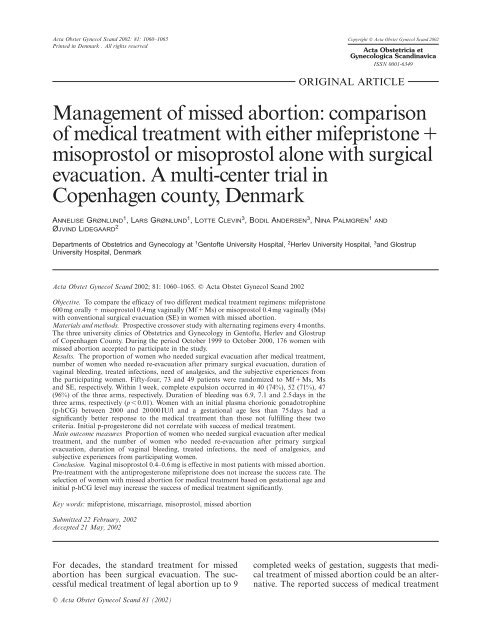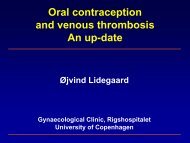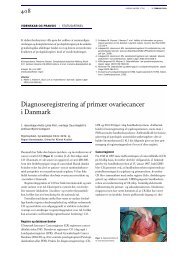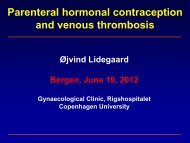Management of missed abortion: comparison of ... - Lidegaard.dk
Management of missed abortion: comparison of ... - Lidegaard.dk
Management of missed abortion: comparison of ... - Lidegaard.dk
You also want an ePaper? Increase the reach of your titles
YUMPU automatically turns print PDFs into web optimized ePapers that Google loves.
Acta Obstet Gynecol Scand 2002: 81: 1060–1065 Copyright C Acta Obstet Gynecol Scand 2002<br />
Printed in Denmark . All rights reserved<br />
Acta Obstetricia et<br />
Gynecologica Scandinavica<br />
ISSN 0001-6349<br />
ORIGINAL ARTICLE<br />
<strong>Management</strong> <strong>of</strong> <strong>missed</strong> <strong>abortion</strong>: <strong>comparison</strong><br />
<strong>of</strong> medical treatment with either mifepristoneπ<br />
misoprostol or misoprostol alone with surgical<br />
evacuation. A multi-center trial in<br />
Copenhagen county, Denmark<br />
ANNELISE GRØNLUND 1 ,LARS GRØNLUND 1 ,LOTTE CLEVIN 3 ,BODIL ANDERSEN 3 ,NINA PALMGREN 1 AND<br />
ØJVIND LIDEGAARD 2<br />
Departments <strong>of</strong> Obstetrics and Gynecology at 1 Gent<strong>of</strong>te University Hospital, 2 Herlev University Hospital, 3 and Glostrup<br />
University Hospital, Denmark<br />
Acta Obstet Gynecol Scand 2002; 81: 1060–1065. C Acta Obstet Gynecol Scand 2002<br />
Objective. To compare the efficacy <strong>of</strong> two different medical treatment regimens: mifepristone<br />
600 mg orally π misoprostol 0.4 mg vaginally (MfπMs) or misoprostol 0.4mg vaginally (Ms)<br />
with conventional surgical evacuation (SE) in women with <strong>missed</strong> <strong>abortion</strong>.<br />
Materials and methods. Prospective crossover study with alternating regimens every 4months.<br />
The three university clinics <strong>of</strong> Obstetrics and Gynecology in Gent<strong>of</strong>te, Herlev and Glostrup<br />
<strong>of</strong> Copenhagen County. During the period October 1999 to October 2000, 176 women with<br />
<strong>missed</strong> <strong>abortion</strong> accepted to participate in the study.<br />
Results. The proportion <strong>of</strong> women who needed surgical evacuation after medical treatment,<br />
number <strong>of</strong> women who needed re-evacuation after primary surgical evacuation, duration <strong>of</strong><br />
vaginal bleeding, treated infections, need <strong>of</strong> analgesics, and the subjective experiences from<br />
the participating women. Fifty-four, 73 and 49 patients were randomized to MfπMs, Ms<br />
and SE, respectively. Within 1 week, complete expulsion occurred in 40 (74%), 52 (71%), 47<br />
(96%) <strong>of</strong> the three arms, respectively. Duration <strong>of</strong> bleeding was 6.9, 7.1 and 2.5days in the<br />
three arms, respectively (p 0.01). Women with an initial plasma chorionic gonadotrophine<br />
(p-hCG) between 2000 and 20 000 IU/l and a gestational age less than 75days had a<br />
significantly better response to the medical treatment than those not fulfilling these two<br />
criteria. Initial p-progesterone did not correlate with success <strong>of</strong> medical treatment.<br />
Main outcome measures Proportion <strong>of</strong> women who needed surgical evacuation after medical<br />
treatment, and the number <strong>of</strong> women who needed re-evacuation after primary surgical<br />
evacuation, duration <strong>of</strong> vaginal bleeding, treated infections, the need <strong>of</strong> analgesics, and<br />
subjective experiences from participating women.<br />
Conclusion. Vaginal misoprostol 0.4–0.6 mg is effective in most patients with <strong>missed</strong> <strong>abortion</strong>.<br />
Pre-treatment with the antiprogesterone mifepristone does not increase the success rate. The<br />
selection <strong>of</strong> women with <strong>missed</strong> <strong>abortion</strong> for medical treatment based on gestational age and<br />
initial p-hCG level may increase the success <strong>of</strong> medical treatment significantly.<br />
Key words: mifepristone, miscarriage, misoprostol, <strong>missed</strong> <strong>abortion</strong><br />
Submitted 22 February, 2002<br />
Accepted 21 May, 2002<br />
For decades, the standard treatment for <strong>missed</strong><br />
<strong>abortion</strong> has been surgical evacuation. The successful<br />
medical treatment <strong>of</strong> legal <strong>abortion</strong> up to 9<br />
completed weeks <strong>of</strong> gestation, suggests that medical<br />
treatment <strong>of</strong> <strong>missed</strong> <strong>abortion</strong> could be an alternative.<br />
The reported success <strong>of</strong> medical treatment<br />
C Acta Obstet Gynecol Scand 81 (2002)
Missed <strong>abortion</strong> 1061<br />
<strong>of</strong> <strong>missed</strong> <strong>abortion</strong> has been conflicting (1–5),<br />
whereas expectant management <strong>of</strong> <strong>missed</strong> <strong>abortion</strong><br />
with success rates <strong>of</strong> only 25% has been disappointing<br />
(5). The differences in success <strong>of</strong> medical<br />
treatment may be a result <strong>of</strong> differences in patient<br />
selection or differences in medicine type, dose and<br />
the method <strong>of</strong> application, as well as the generally<br />
small number <strong>of</strong> patients included in the studies.<br />
The best results have been achieved by vaginal application<br />
<strong>of</strong> the prostaglandin misoprostol in doses<br />
<strong>of</strong> at least 0.4 mg, with success rates up to 88%<br />
(3, 6). Giving the antiprogesterone mifepristone as<br />
pretreatment has not increased the success rates<br />
substantially; 52–92% (1, 2, 4).<br />
The aim <strong>of</strong> this study was to compare two different<br />
medical treatment regimens with surgical<br />
evacuation <strong>of</strong> the uterus in the treatment <strong>of</strong> <strong>missed</strong><br />
<strong>abortion</strong>.<br />
Materials and methods<br />
The <strong>missed</strong> <strong>abortion</strong> study spanned the 12<br />
months from October 1999 to October 2000 and<br />
was designed as a prospective cross-over study<br />
between three gynecologic departments in Gent<strong>of</strong>te,<br />
Herlev and Glostrup, all in Copenhagen<br />
County. Copenhagen County has 609000 citizens,<br />
314 000 are women, and 140000 <strong>of</strong> these are <strong>of</strong><br />
reproductive age. The three participating centers<br />
were randomized to alternating treatments every<br />
4 months. The women did not know the result <strong>of</strong><br />
the randomization until after having given their<br />
consent.<br />
The specific entry criteria were: a positive urine<br />
human chorionic gonadotrophin (hCG) or plasma<br />
(p)-hCG30 IU/l and no fresh vaginal bleeding<br />
and one <strong>of</strong> the following four vaginal ultrasound<br />
(US) criteria being fulfilled:<br />
1) Foetus with crown rump length (CRL) 6–20<br />
mm with no embryonic cardiac activity, or<br />
2) Foetus with CRL 6 mm, no embryonic cardiac<br />
activity and a verified gestational age <strong>of</strong> at<br />
least 6 completed weeks or a rise in p-hCG level<br />
<strong>of</strong> less than 20%/day or<br />
3) Anembryonic pregnancy with an empty gestational<br />
sac <strong>of</strong> at least 12 mm and no growth<br />
over at least 3 days or<br />
4) Anembryonic pregnancy with an empty gestational<br />
sac <strong>of</strong> at least 15 mm and amenorrhea<br />
<strong>of</strong> at least 6 weeks.<br />
A CRL <strong>of</strong> 20 mm was chosen as the upper limit<br />
because it corresponds to the maximum size <strong>of</strong><br />
CRL in the medical legal termination <strong>of</strong> pregnancy<br />
accepted at the three participating centers.<br />
If the patient fulfilled the entry criteria she was<br />
informed about the study, and participating<br />
women gave written informed consent.<br />
Patients with fresh bleeding were referred to a<br />
spontaneous <strong>abortion</strong> study, which was on-going<br />
at the same centers.<br />
The exclusion criteria were suspicion <strong>of</strong> ectopic<br />
pregnancy, allergy or contraindications for mifepristone<br />
or misoprostol, sign <strong>of</strong> infection, age below<br />
18years, or women not speaking Danish. Patients<br />
who did not want to participate or patients who<br />
did not fulfil the entry criteria were <strong>of</strong>fered surgical<br />
evacuation.<br />
The three treatment regimens were:<br />
1. Medical treatment (MfπMs) with a single dose<br />
<strong>of</strong> mifepristone 600mg orally on day one. The<br />
patient returned to the gynecologic ward on day<br />
3 and was given misoprostol 0.4mg vaginally. If<br />
no vaginal bleeding occurred within 2h, additional<br />
misoprostol 0.2mg was given. The patient<br />
was observed for 4h in the department.<br />
2. Medical treatment only with misoprostol 0.4 mg<br />
vaginally on day 1 (Ms). If no vaginal bleeding<br />
occurred within 2h, additional misoprostol 0.2<br />
mg was given. The women were observed for 4<br />
h in the department.<br />
3. Surgical evacuation in general anesthesia. On<br />
day 1, before treatment, p-progesterone (nmol/<br />
l) and p-hCG (IU/l) were measured. P-hCG<br />
samples were repeated on day 8 and day 14. All<br />
patients were <strong>of</strong>fered 100mg <strong>of</strong> dicl<strong>of</strong>enac rectally<br />
for pain relief at the time <strong>of</strong> giving misoprostol<br />
or immediately after surgical evacuation.<br />
Rh-anti-D-immunoglobulin was <strong>of</strong>fered to all<br />
Rh-negative women. A US examination was<br />
conducted on day 8. If the US was unchanged<br />
or the anterior-posterior diameter <strong>of</strong> the midline<br />
echo was 20mm, surgical evacuation or<br />
(in the case <strong>of</strong> primary evacuation) re-evacuation<br />
was performed.<br />
All patients were asked to return a questionnaire<br />
after 14days. They were asked about the length <strong>of</strong><br />
bleeding, spotting, need <strong>of</strong> analgesics, if they had<br />
received any antibiotics for pelvic inflammatory<br />
disease (PID), and for their own subjective evaluation<br />
<strong>of</strong> the treatment. They were asked, if they<br />
would choose the same procedure if they had to go<br />
through it again. If they did not want the same<br />
procedure, they were asked why not.<br />
The main outcome measures were: need <strong>of</strong> surgical<br />
evacuation after medical treatment, need <strong>of</strong> reevacuation<br />
after SE, duration <strong>of</strong> vaginal bleeding,<br />
incidence <strong>of</strong> treated infections, need <strong>of</strong> analgesics,<br />
and the subjective experiences indicated in the returned<br />
questionnaires.<br />
C Acta Obstet Gynecol Scand 81 (2002)
1062 A. Grønlund et al.<br />
Table I. Characteristics <strong>of</strong> the women at inclusion<br />
Mifepristone π misoprostol Misoprostol Surgical treatment<br />
n Ω 54 n Ω 73 n Ω 49<br />
Age (years) Mean 32.0 32.1 31.6<br />
Range 20–46 20–45 18–43<br />
Pregnancy length (days) Mean 73.2 67.2 76.2<br />
Range 45–114 38–125 51–127<br />
P-progesterone day 1 (nmol/l) Mean 40.8 37.1 31.7<br />
Range 8–240 1–148 1–81<br />
P-hCG day 1 (IU/l) Mean 21.052 25.011 14.817<br />
Range 751–196 324 79–184 400 192–75 000<br />
Table II. Result <strong>of</strong> treatment with mifepristone π misoprostol, misoprostol, and surgical evacuation <strong>of</strong> <strong>missed</strong> <strong>abortion</strong>, respectively<br />
Mifepristone π misoprostol Misoprostol Surgical treatment<br />
n Ω 54 n Ω 73 n Ω 49<br />
Emergency evacuation n (%) 6 (11.1)* 1 (4.1) ref. –<br />
All evacuations n (%) 14 (25.9) 21 (28.8) 2 (4.1)<br />
Treated pelvic infection n (%) 1 (1.9) 3 (1.4) 2 (1.4)<br />
Blood transfusion n (%) 0 0 0<br />
Analgesic need (days) Mean 2.5 1.7 1.5<br />
Range 0–15 0–7 0–10<br />
Duration <strong>of</strong> bleeding (days) Mean 6.9** 7.1** 2.6<br />
Range 0–15 0–16 0–9<br />
Duration <strong>of</strong> spotting† (days) Mean 4.7 3.9 4.7<br />
Range 3–27 1–24 0–17<br />
Recommended by client n (%) 29/46 (63) 50/65 (77) 38/45 (84)<br />
*p 0.05, **p 0.001.<br />
†Beyond days <strong>of</strong> regular bleeding.<br />
The study was approved by the Scientific Ethics<br />
Committee <strong>of</strong> Copenhagen County (KA 99102s).<br />
Test <strong>of</strong> significance was calculated by the quisquare<br />
test. Length <strong>of</strong> bleeding was tested also<br />
with the nonparametric Wilcoxon test. The level <strong>of</strong><br />
significance was set at 5%.<br />
Results<br />
During the study period, 365 patients were admitted<br />
with <strong>missed</strong> <strong>abortion</strong>. Of these, 297 fulfilled the<br />
entry criteria, and 176 patients accepted inclusion<br />
into the study. Among the 365 patients, the main<br />
reasons not to participate in the study were: CRL<br />
20 mm at day 1, n Ω 27; language problems, n Ω<br />
19; or the women did not want to participate, n Ω<br />
110.<br />
The study population is described in TableI.<br />
There were no significant differences between the<br />
three treatment groups according to age, pregnancy<br />
length, and p-hCG or p-progesterone on<br />
day 1.<br />
The Mf π Ms treatment was successful (no<br />
evacuation) in 40 <strong>of</strong> 54 (74%) women, and Ms in<br />
52 <strong>of</strong> 73 (71%) patients. SE was successful (no reevacuation)<br />
in 47 <strong>of</strong> 49 (96%) clients (TableII).<br />
Additional misoprostol 0.2mg was given to 13/<br />
54 patients (24%) in the MfπMs group, and to<br />
43/73 patients (59%) in the Ms group. There was<br />
no difference in either group in the proportion<br />
given an extra dose <strong>of</strong> misoprostol between those<br />
who succeeded in the treatment and those who<br />
underwent evacuation (TableIII).<br />
Significantly more patients needed acute evacuation<br />
because <strong>of</strong> heavy bleeding in the MfπMs<br />
group 6/54 (11%) compared with the Ms group 1/<br />
73 (1%) (p0.05). Five <strong>of</strong> the patients in the Mf<br />
π Ms group were evacuated after having received<br />
mifepristone only. No patient in the study group<br />
needed a blood transfusion. One <strong>of</strong> the six patients<br />
with heavy bleeding had tissue in her cervical ca-<br />
Table III Number <strong>of</strong> patients given additional misoprostol 0.2 mg<br />
Mifepristone<br />
π misoprostol Misoprostol<br />
n Ω 54 n Ω 73<br />
Secondary evacuation n (%) 2/14 (14) 13/21 (62)<br />
No secondary evacuation n (%) 11/40 (28) 30/52 (58)<br />
Total n (%) 13/54 (24) 43/73 (59)<br />
C Acta Obstet Gynecol Scand 81 (2002)
Missed <strong>abortion</strong> 1063<br />
Table IV. Why the women did not recommend the same treatment again<br />
Mifepristone<br />
Surgical<br />
π misoprostol Misoprostol treatment<br />
n Ω 46 n Ω 66 n Ω 45<br />
Treatment unsuccessful n (%) 9 (20) 11 (17)<br />
Length <strong>of</strong> bleeding n (%) 10 (22) 5 (8)<br />
Length <strong>of</strong> pain n (%) 9 (20) 7 (11)<br />
Medical side-effects n (%) 6 (13) 3 (5)<br />
Want to sleep n (%) 4 (9) 4 (6)<br />
Want to be awaked n (%) 2 (4)<br />
Instrumentation unwanted n (%) 6 (13)<br />
Anesthetic side-effects n (%) 4 (9)<br />
nal, which was removed by a ring forceps and was<br />
why surgical evacuation was not necessary.<br />
One patient (2%) in the MfπMs group was<br />
treated with antibiotics because <strong>of</strong> PID compared<br />
with three patients (4%) in the Ms group and two<br />
(4%) patients in the SE group. One patient developed<br />
allergic symptoms (urticaria and itching<br />
treated with antihistamines) after the administration<br />
<strong>of</strong> mifepristone.<br />
Distribution <strong>of</strong> the patients according to the<br />
four ultrasound criteria: 72 had CRL 6–20 mm and<br />
no heart activity, 27 had a CRL 6 mm and a gestational<br />
age <strong>of</strong> more than 6 weeks or an insufficient<br />
hCG increase, 15 had a gestational sac 12mm<br />
with no embryo, and 62 had an empty gestational<br />
sac 15 mm. There was no difference in the success<br />
rates according to these US criteria.<br />
The overall return rate <strong>of</strong> the questionnaires was<br />
156/176 or 89% (Table II). The length <strong>of</strong> bleeding<br />
was significantly longer in the two medically<br />
treated groups: 6.9days and 7.1days vs. 2.6days in<br />
the surgical group (p0.001). The need <strong>of</strong> analgesics<br />
in the MfπMs group was 2.5days, in the<br />
Ms group 1.7days, and in the SE group was 1.5<br />
days (NS).<br />
The patients who underwent primary SE were<br />
concerned about the instrumentation <strong>of</strong> the uterus,<br />
n Ω 5, or about the anesthesia, n Ω 3. In the Mf<br />
π Ms group 63% and in the Ms group 76% recommended<br />
the treatment. The main reasons for not<br />
recommending the medical treatment were (Table<br />
IV): unsuccessful treatment: MfπMs, n Ω 9, and<br />
Ms, n Ω 11; length <strong>of</strong> bleeding: MfπMs, n Ω 10<br />
and Ms, n Ω 5; and pain: Mf π Ms, n Ω 9, and<br />
Ms, n Ω 7. There was no difference between the<br />
two medical treatment groups.<br />
We did not find any individual prediction for a<br />
secondary evacuation according to gestational age,<br />
initial p-hCG or in p-progesterone on day one<br />
(Fig.1).<br />
However, combining p-hCG and gestational age<br />
revealed a group <strong>of</strong> women with a low incidence <strong>of</strong><br />
evacuation (Fig.1). Of those 41 with a p-hCG <strong>of</strong><br />
between 2000 and 20000 and a gestational age less<br />
than 75days, only four (10%) were evacuated compared<br />
with an evacuation rate <strong>of</strong> 35% among the<br />
82 women not fulfilling these criteria (p0.05).<br />
Discussion<br />
In TableV, we have summarized the results from<br />
five previous studies and from this study. It appears<br />
that our results are comparable with previous<br />
findings. Additional misoprostol 0.2mg was<br />
Table V. Medical treatment <strong>of</strong> <strong>missed</strong> <strong>abortion</strong>. Results from six studies<br />
Author ref El-Refaey (1) Lelaidier (2) Creinin (3) Nielsen (4) Zalányi (6) This study<br />
Year <strong>of</strong> publication 1992 1993 1997 1997 1998 2001<br />
Nationality English French American Swedish Hungarian Danish<br />
No. <strong>of</strong> patients 60 44 20 31 25 127<br />
Regimen<br />
Mifepristone 600 mg orally 600 mg orally Not given 400 mg orally Not given 600 mg orally/No*<br />
Misoprostol 600 ug orally not given 400 ug oral800 ug vg 400 ug orally 400 vaginally 400 ug vaginally<br />
Control US US US US US US, hCG<br />
Control time 4 h, days 10–14 Day 5 Day 1 π 2 Day 6 10 h Day 8 π 14<br />
Results<br />
Included 59 23 12/8 31 25 54/73*<br />
Complete <strong>abortion</strong> 51 17 1/5 16 18 40/52*<br />
Complete anp † 5 – 2/2 – 4 –<br />
Success rate 95% 74% 25%/88% 52% 88% 74%/71%*<br />
Failed 3 6 9/1 15 3 14/21*<br />
Failure rate 5% 26% 75%/12% 48% 12% 26%/29%*<br />
Evacuated if Gestational sac or Not indicated Gestational sac Retained products Retained products Retained products<br />
no bleeding 15 mm 15 mm 20 mm<br />
*Only misoprostol 400 ug vaginally.<br />
† anp Ω after new prostaglandin application.<br />
C Acta Obstet Gynecol Scand 81 (2002)
1064 A. Grønlund et al.<br />
Fig. 1. Plasma-hCG levels and gestational age at inclusion in<br />
women who did (π) and did not need (æ) evacuation <strong>of</strong> the<br />
uterus.<br />
given to 59% in the Ms group, which could indicate<br />
a too low initial dose. Zalányi found an effect<br />
<strong>of</strong> vaginal misoprostol in doses up to 0.6mg, but<br />
no further effect <strong>of</strong> higher doses (6). El-Refaey received<br />
95% success with a regimen <strong>of</strong> oral mifepristone<br />
600 mg π oral misoprostol 0.6 mg (1). El-Refaey<br />
later demonstrated that vaginal administration<br />
<strong>of</strong> misoprostol is more effective than if given<br />
orally (7). Both studies had a high expulsion rate<br />
<strong>of</strong> 88% and 95%, respectively, compared with our<br />
rate <strong>of</strong> 75%. This may have been because <strong>of</strong> the<br />
fact that these two studies defined successful treatment<br />
as no visible gestational sac, whereas other<br />
investigators (4, 6) defined successful treatment according<br />
to a reduction in the anterior-posterior diameter<br />
<strong>of</strong> the midline echo. We defined successful<br />
treatment as an anterior-posterior diameter <strong>of</strong> less<br />
than 20 mm on day 8, and we had no patients<br />
fulfilling these criteria who were readmitted with<br />
retained intrauterine products after discharge. Creinin<br />
et al. found an expulsion rate <strong>of</strong> 88% on a<br />
regimen <strong>of</strong> vaginal misoprostol 0.8 mg, but the<br />
number <strong>of</strong> patients (n Ω 8) was low (3).<br />
Oral mifepristone has been used with different<br />
success. Lelaidier et al. obtained a success rate <strong>of</strong><br />
74% with mifepristone 600 mg orally (2), while<br />
Nielsen et al. reached 52% using mifepristone 400<br />
mg orally combined with misoprostol 0.4 mg orally<br />
(4). The dissimilarities <strong>of</strong> these reports may be the<br />
result <strong>of</strong> the small number <strong>of</strong> patients included,<br />
differences in patient selection, and in the outcome<br />
measures used to define success. We did not find<br />
any improvement in the expulsion rate by pretreatment<br />
with mifepristone. Our hypothesis is that<br />
antiprogesterone is not necessary for the medical<br />
termination <strong>of</strong> <strong>missed</strong> <strong>abortion</strong> because the function<br />
<strong>of</strong> the placenta is <strong>of</strong>ten already abnormal. On<br />
the other hand, prostaglandin is required to initiate<br />
uterine contractions and expulsion <strong>of</strong> the<br />
conception product. Pre-treatment with antiprogesterone<br />
in women with <strong>missed</strong> <strong>abortion</strong> may in-<br />
crease the risk <strong>of</strong> heavy bleeding, as this complication<br />
has been reported in our and two previous<br />
studies (2, 4).<br />
The reason for the lower efficacy <strong>of</strong> misoprostol<br />
in <strong>missed</strong> as compared to induced <strong>abortion</strong> is<br />
probably because women who do not experience a<br />
spontaneous expulsion <strong>of</strong> the dead foetus are a select<br />
group <strong>of</strong> women in whom the pregnancy is<br />
relatively difficult to expulse as compared to<br />
women who begin their <strong>abortion</strong> process spontaneously.<br />
We found that women with an initial p-hCG between<br />
2000 and 20000IU/l and a gestational age<br />
<strong>of</strong> less than 75days had a significantly better<br />
chance <strong>of</strong> responding to a medical regimen. Jurkovic<br />
et al. found a positive predictive value with<br />
low gestational age (5), and Lelaidier et al. found<br />
a positive prediction for successful medical treatment<br />
in women with low initial p-hCG and p-progesterone<br />
and high gestational age (2). The clinical,<br />
US inclusion criteria and initial p-progesterone<br />
level did not correlate to the success <strong>of</strong> the medical<br />
treatment in our study.<br />
Despite the fact that surgical evacuation <strong>of</strong><br />
women with <strong>missed</strong> <strong>abortion</strong> is effective in more<br />
than 95% <strong>of</strong> cases, there are three reasons for<br />
searching for a medical alternative. Many women<br />
prefer a less invasive way <strong>of</strong> terminating their pregnancy<br />
in case <strong>of</strong> <strong>missed</strong> <strong>abortion</strong> (and legal medical<br />
<strong>abortion</strong>), and also wish to be awake during the<br />
treatment despite the fact that they might experience<br />
more pain and longer bleeding compared with<br />
women undergoing primary surgical evacuation.<br />
Second, even though approximately 25% <strong>of</strong> medically<br />
treated women undergo secondary surgical<br />
evacuation, they may still have a lower infection risk<br />
as compared to women primarily undergoing surgical<br />
evacuation. Third, the waiting time for the operating<br />
theatre may (at least in Denmark) sometimes<br />
be days, whereas medical treatment may be initiated<br />
immediately after diagnosis. Medical treatment in<br />
<strong>missed</strong> <strong>abortion</strong> as an alternative to evacuation was<br />
also recommended in two recent surveys (8, 9).<br />
With the inclusion criteria used in this study, the<br />
medical treatment <strong>of</strong> <strong>missed</strong> <strong>abortion</strong> does not<br />
seem to increase the risk <strong>of</strong> missing a diagnosis <strong>of</strong><br />
ectopic pregnancy or hydatid mola. The approximate<br />
4.5-day longer period <strong>of</strong> bleeding in medical<br />
treatment did not, among the women participating<br />
in this study, imply a rejection <strong>of</strong> the method. It is<br />
undoubtedly important that medically treated<br />
women are informed to expect a few days more<br />
bleeding.<br />
The identified group receiving the highly successful<br />
medical treatment (according to gestational age<br />
and p-hCG level) need confirmation in other<br />
studies. If this finding is confirmed in future studies,<br />
C Acta Obstet Gynecol Scand 81 (2002)
Missed <strong>abortion</strong> 1065<br />
we should probably recommend primary medical<br />
treatment for women fulfilling the criteria, and primary<br />
surgical evacuation for those who do not.<br />
Conclusion<br />
Vaginally applied misoprostol 0.4–0.6 mg is an<br />
alternative treatment in most patients with <strong>missed</strong><br />
<strong>abortion</strong>. Pre-treatment with mifepristone does<br />
not increase the expulsion rate, but may increase<br />
the risk <strong>of</strong> heavy bleeding. Gestational age and an<br />
initial plasma level <strong>of</strong> hCG or progesterone do not<br />
individually predict the success <strong>of</strong> medical treatment.<br />
On the other hand, the combination <strong>of</strong> a<br />
gestational age <strong>of</strong> less than 75 days and initial<br />
plasma levels <strong>of</strong> hCG between 2000 and 20000IU/<br />
l may imply higher success <strong>of</strong> medical treatment<br />
than in those women not fulfilling these criteria.<br />
Our tentative recommendation for medical<br />
treatment in women with <strong>missed</strong> <strong>abortion</strong> is vaginally<br />
applied misoprostol 0.4–0.6 mg, if necessary<br />
supplemented with a further 0.2 mg in instances<br />
<strong>of</strong> no bleeding 2 h after the primary application.<br />
References<br />
1. El-Refaey H, Hinshaw K, Henshaw R, Smith N, Templeton<br />
A. Medical management <strong>of</strong> <strong>missed</strong> <strong>abortion</strong> and anembryonic<br />
pregnancy. BMJ 1992; 305: 1399.<br />
2. Leladier C, Baton-Saint-Mleux C, Fernandez H, Bourget<br />
P, Frydman R. Mifepristone (RU 486) induces embryo expulsion<br />
in first trimester non-developing pregnancies: a<br />
prospective randomised trial. Hum Reprod 1993; 8: 492–5.<br />
3. Creinin MD, Moyer R, Guido R. Misoprostol for medical<br />
evacuation <strong>of</strong> early pregnancy failure. Obstet Gynecol<br />
1997; 89: 768–72.<br />
4. Nielsen S, Hahlin M, Platz-Christensen JJ. Unsuccessful<br />
treatment <strong>of</strong> <strong>missed</strong> <strong>abortion</strong> with a combination <strong>of</strong> an<br />
antiprogesterone and a prostaglandine E1 analogue. Br J<br />
Obstet Gynaecol 1997; 104: 1094–6.<br />
5. Jurkovic D, Ross JA, Nicolaides KH. Expectant management<br />
<strong>of</strong> <strong>missed</strong> miscarriage. Br J Obstet Gynaecol 1998;<br />
105: 670–1.<br />
6. Zalányi S. Vaginal misoprostol alone is effective in the<br />
treatment <strong>of</strong> <strong>missed</strong> <strong>abortion</strong>. Br J Obstet Gynaecol 1998;<br />
105: 1026–35.<br />
7. El-Rafaey H, Rajasekar D, Abdalla M, Calder L, Templeton<br />
A. Induction <strong>of</strong> <strong>abortion</strong> with mifepristone (RU<br />
486) and oral or vaginal misoprostol. N Engl J Med 1995;<br />
332: 983–7.<br />
8. Goldberg AB, Greenberg MB, Darney PD. Drug therapy.<br />
Misoprostol pregnancy. N Engl J Med 2001; 344: 38–47.<br />
9. Blanchard K, Clark S, Winik<strong>of</strong>f B, Gaines G, Kabani G,<br />
Shannon C. Misoprostol for women’s health. A Review.<br />
Obstet Gynecol 2002; 99: 316–32.<br />
Address for correspondence:<br />
Øjvind <strong>Lidegaard</strong><br />
Department <strong>of</strong> Obstetrics and Gynaecology<br />
Herlev University Hospital<br />
DK-2730 Herlev<br />
Denmark<br />
e-mail: lidegaard/dadlnet.<strong>dk</strong><br />
C Acta Obstet Gynecol Scand 81 (2002)









